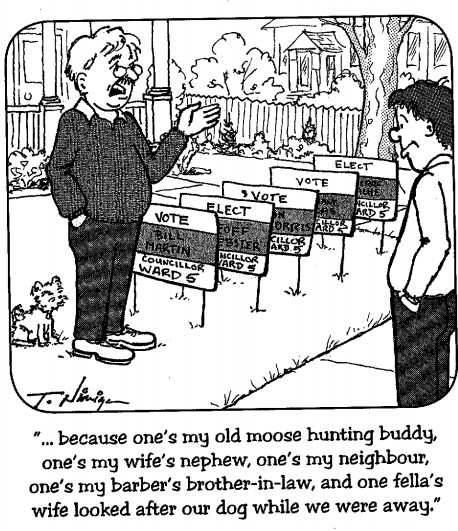Section 42 of the Municipal Elections Act allows a municipality to pass a by-law authorizing voting by alternative voting methods such as mail or by telephone, that does not require electors to attend at a voting place in order to vote.
Napanee passed by-law 2013-0036 on August 13, 2013 allowing voting by telephone or internet in the 2014 election. See the Town Website Elections Page.
The Act contains a curious provision that, in the case of telephone voting, the clerk can establish other procedures and forms, if they are consistent with the principles of this Act. Once established, the clerk’s procedure and forms prevail over anything in the Act.
The decision generated a lot of debate and confusion. The election results for the position of mayor were close with Schermerhorn winning over Dorey by 3 votes. A recount was requested and the clerk printed out the same .pdf page again which was obviously a laughably foolish exercise and demonstrates the most serious criticisms of the process – that there is no way to verify it’s accuracy and it compromises public trust in the election process.
In cyberspace there is no equivalent of scrutineers or the opening the ballot box.
The clerk delivered a glowing report on the election process. See: Staff Report on 2014 Election
Robert Dorey, delivered a thoughtful and well-reasoned reply in the Napanee Beaver. See: Robert Dorey Letter to Editor re election process published in Napanee Beaver May 21, 2015
Brian Hughes, delivered and equally thoughtful reply in the Beaver. See: Napanee Beaver May 28, 2015
Everyone, including the clerk, agrees that the voters list was a mess. The preliminary list of electors was generated by MPAC, which explains everything. The clerk had limited powers to amend the voters list and did what she could to correct the horrible mess MPAC handed her.
The problem is not hard to find. Every parcel of property in Ontario has a Property Identification Number (PIN) for land registry purposes. Each parcel also has an assessment roll number. In many cases there is a one to one match between the two, but not always. For example a farm with land on both sides of the road might have two PINs but only one roll number. And a farm assembled from smaller ones might have separate roll numbers but only one PIN. This causes a lot of confusion.
MPAC receives a copy of every transfer of property (deed) filed in Ontario and generates their list of owners, their addresses and the assessment database from that. However, the land transfers (deeds) often contain errors in addresses and roll numbers with are not caught by MPAC. This can result in errors in the voter’s list and even tax bills going astray. Remember, not everyone lives on the property they own.
The bigger problem is occupants (eg adult children living at home) and tenants. MPAC generates the list of occupants from data received from the owners. Usually when an owner receives an assessment notice which starts by announcing “This is not a tax bill” he breathes a sign of relief and throws it out without checking the occupant data. So, it never gets corrected.
Section 16.1 of the Assessment Act requires owners of buildings with 7 or more residential units to file a list of tenants by August each year. But few landlords are aware of this requirement and MPAC has no adequate process to remind them. And there is no process to capture the names of tenants of buildings with 6 or fewer units which, in Napanee, are the majority of them. Also, the average stay of a tenant in Napanee is less than 2 years, so tenant data goes out of date very quickly.
The voters list has always been a problem but the potential for misuse is much greater with internet voting. If you doubt this, just go to your favourite social media site and watch people doing things at a keyboard that they would never do elsewhere. There is nothing as reassuring as showing up at a polling station in person and looking the deputy returning officer and scrutineers in the eye while you ask for your ballot. MPAC’s preliminary list of electors was years out of date for tenants and hundreds of ballots for tenants who had moved on years earlier were thrown into apartment recycling bins. Amazingly, there was no evidence of misuse, but the lack of trust in the result is still troublesome.
The other issue, which has hardly been raised is the extent to which an electronic election changes the profile of the voters who actually vote. The number of voters increased with the electronic balloting probably because the candidates had a whole week to hound their supporters and watch to see if they actually got out. But few tenants received a ballot. They could add their name to the voters list by going to Town Hall but probably few did. Arguably, the voter profile favoured property owners. It may have favoured those who use computers over those who don’t. And candidates who were internet savvy probably had an advantage. Also, the opportunity that candidates had (via the candidate module) to view who had voted and who hadn’t during the week before election day favoured the candidates who canvassed hard and made up a list of supporters enabling them to chase down supporters over a whole week.
On November 10, 2015, council was given a letter from MPAC with a final report on the 2014 enumeration process. MPAC admitted that it’s accuracy rate had fallen from 90% in 2010 to 87% in 2014. But, somehow, they felt this was a success because they had only spent 30% of what they had spent in 2014 and they ended their letter with a plea to get somebody to do this because only 1% of Ontarions are happy with what they do:
While we consider 2014 an overall success, it is important to recognize that MPAC is an assessment authority, not an elections agency. Therefore, as part of the current review of the Municipal Elections Act, 1996 conducted by the Ministry of Municipal Affairs and Housing, and in collaboration with AMCTO and key government bodies such as Elections Ontario and the Ministry of Finance, we continue to explore available options for transitioning enumeration activities, including preparation of the Preliminary List of Electors, to another entity. This direction is fully supported by MPAC’s Board of Directors and Executive Management Group. This initiative aligns with the results of a 2013 MPAC sponsored IPSOS survey of public perceptions concerning municipal elections. The results were quite clear. When asked who respondents would most likely contact to confirm if they were on the Voters’ List, only 1% identified MPAC as the responsible body. The most common choice was Elections Ontario at 27%, while 24% selected their local Municipal Office and another 18% identified Elections Canada. As a result of membership surveys and their own deliberations, the AMCTO is strongly advocating that an electoral agency would be better positioned to provide the PLE for municipal elections.
That’s something everyone could agree on.
On November 10 Councillor Lucas (Ward 5) made a Motion to have MPAC attend and explain the horrible mess they had made. The motion was seconded by councillor Harvey (Ward 4) and considered on November 24. The rest of council seemed reluctant at first and the clerk reported that the Province was reviewing the Municipal Elections Act and the review would be complete before the next election. The Motion was amended to copy the letter to the Ministry of Municipal Affairs and also to meet with MPAC at the Rural Ontario Municipal Association convention and eventually passed unanimously. See Beaver November 26.
 On June 27, 2017, the Clerk presented a report on bids for electronic voting for the 2018 election. She recommended that the Town again use Intelivote at a cost of $2.50 – $2.60 per elector. Council approved.
On June 27, 2017, the Clerk presented a report on bids for electronic voting for the 2018 election. She recommended that the Town again use Intelivote at a cost of $2.50 – $2.60 per elector. Council approved.
See the following links:
- Municipal Elections Act
- 2014 Election Results
- Staff Report on 2014 Election
- list of Candidates in 2014 Election and their contact information
Greater Napanee News Report on All Candidates Meeting 2014 (Mayor/Deputy Mayor)
Greater Napanee News Report on All Candidates Meeting 2014 (Councillors)
Get Involved.
NRP Directors
Explore Napanee
There is no cost to join and/or receive our newletters by e-mail. Everyone is welcome to contribute content. Just click on Make Comments Here at the top of any page to post a comment on any issue on this website. We’ve only been up since May 17, 2015 and we’re anxious to build content on issues of interest to everyone in the Town of Greater Napanee. Shortly, we’ll be adding blogs on each page which will allow you to contribute on-line. We’ll also be adding a module which will let you join on-line and receive our free newsletter. In the meantime, just send an e-mail to napaneeratepayers@gmail.com to get our newsletter.
Hubert Hogle 532-3672
hogles2@yahoo.ca
Dennis Mills 354-6375
d.smills@sympatico.ca
Arthur Ronald 354-4291
brodick1960@gmail.com
We have added six additional directors, John Wilson, Judy Wood, John Stinson, Briane Birney, Suzy Sheltler and Anne Hogle. All residents and taxpayers in Greater Napanee are welcome to become members and all interested parties are welcome to receive our regular newsletters and contribute content to the website. If you are interested in serving as a director, let us know.


